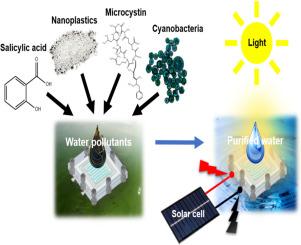Water purification of organic pollutants using photocatalytic microreactors integrating Au/TiO₂/carbon cloth under solar irradiation
IF 7.1
Q1 ENGINEERING, CHEMICAL
引用次数: 0
Abstract
Water pollution from organic contaminants, microplastics, and cyanotoxins necessitates the development of high-efficiency and scalable purification technologies. However, conventional TiO₂-based photocatalytic systems suffer from low visible-light absorption, rapid charge recombination, and limited mass transport, reducing their practical efficiency. This study presents a novel photoelectrocatalytic (PEC) microreactor integrating Au/TiO₂ nanofibers (NFs) on carbon cloth (CC) to enhance pollutant degradation through localized surface plasmon resonance (LSPR), nonlinear electric fields, and microfluidic transport phenomena. The proposed system achieved 89 % microcystin-LR (MC-LR) degradation in 12.9 min, a reaction rate constant of 10.3 h⁻¹, which is 3 to 100 × higher than conventional TiO₂-based systems. In particular, orbitrap mass spectrometry analysis of the samples after the cyanobacterial degradation experiment confirmed that the toxic compound MC-LR was markedly removed under 1 Sun + 3 V conditions for 5 h, and that the intermediate degradation products of MC-LR were also significantly reduced compared to the control. These enhancements stem from efficient visible-light absorbance, accelerates charge separation, and promotes ion and reactant transport. The scalable modular design enables practical deployment, as validated by outdoor experiments under natural sunlight. This work introduces a high-performance PEC microreactor platform with significant potential for large-scale sustainable wastewater treatment.

Au/TiO 2 /碳布集成光催化微反应器在太阳照射下净化水中有机污染物
来自有机污染物、微塑料和蓝藻毒素的水污染需要开发高效和可扩展的净化技术。然而,传统的tio2基光催化系统存在可见光吸收低、电荷重组快、质量输运有限等问题,降低了其实际效率。本研究提出了一种新型的光电催化(PEC)微反应器,在碳布(CC)上集成Au/TiO₂纳米纤维(NFs),通过局部表面等离子体共振(LSPR)、非线性电场和微流控输运现象来增强污染物的降解。该系统在12.9分钟内实现了89%的微囊藻毒素- lr (MC-LR)降解,反应速率常数为10.3 h⁻¹,比传统的TiO 2基系统高3到100倍。特别是,蓝藻降解实验后样品的轨道rap质谱分析证实,在1 Sun + 3 V条件下5 h,有毒化合物MC-LR被明显去除,MC-LR的中间降解产物也较对照显著减少。这些增强源于有效的可见光吸收,加速电荷分离,促进离子和反应物的传输。可扩展的模块化设计使实际部署成为可能,正如在自然阳光下的室外实验所验证的那样。本文介绍了一种高性能PEC微反应器平台,具有大规模可持续废水处理的巨大潜力。
本文章由计算机程序翻译,如有差异,请以英文原文为准。
求助全文
约1分钟内获得全文
求助全文
来源期刊

Chemical Engineering Journal Advances
Engineering-Industrial and Manufacturing Engineering
CiteScore
8.30
自引率
0.00%
发文量
213
审稿时长
26 days
 求助内容:
求助内容: 应助结果提醒方式:
应助结果提醒方式:


